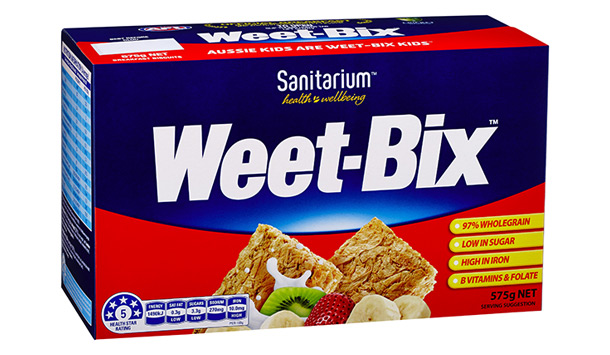 Above: Weet-Bix with its new front of pack Health Star labelling.
Above: Weet-Bix with its new front of pack Health Star labelling.
Weet-Bix and UP&GO are the first Sanitarium products to arrive on shelves with front of pack Health Star labelling. UP&GO scores four and a half stars and Weet-Bix scores five under the Health Star Rating system.
The Health Star Rating system, which was endorsed by the State and Federal Governments in June, scores products on a scale of 0.5 to five stars based on nutrient and whole food content, and is aligned with the Australian Dietary Guidelines. In June, Sanitarium made the commitment to adopt the new Health Star Rating system across its entire product range. Nestle, Woolworths, Coles and several other companies have also either begun using, or have announced that they will adopt the health star rating system.
The ratings take into account the four aspects of food associated with increasing the risk factors for chronic diseases: energy; saturated fat; total sugars; and sodium content. Food products that are low in saturated fat, total sugars, sodium and/or energy will generally have a higher star rating.
Sanitarium will continue to roll out with more products with the pack front ratings until mid-2015. Todd Saunders, general manager, Sanitarium Australia, said Sanitarium was one of the first companies to support the voluntary Health Star Rating labelling system and is proud to be taking a leading role in implementing the important national initiative.
“The Health Star Rating system is an effective way to deliver this and we see the use of a consumer-friendly visual guide on packs as a great way to empower shoppers to make healthy food choices.”
Trish Guy, Australian Practising Dietician and nutritionist at Sanitarium, said the Health Star Rating system makes interpreting the nutritional credentials of a product simpler.
“Nutrition labelling can be difficult to understand and contextualise for many people, so the star system, which is backed by considerable research, provides an easy, reliable reference that consumers can use when selecting products,” she said.
Overseas a research study on ‘The impact of a supermarket nutrition rating system on purchases of nutritious and less nutritious foods’ published in the Cambridge University Press journal ‘Public Health Nutrition’ examined the impact of a nutrition rating system on consumers’ food purchases in supermarkets. The study looked at sales data for 102 categories of food (over 60 000 brands) on a weekly basis for 2005–2007 from a supermarket chain of over 168 stores in the north-east USA, from January 2005 to December 2007.
The study found that after the introduction of the nutrition ratings, overall weekly food sales declined by an average of 3637 units per category. The study concluded that the introduction of the nutrition ratings led shoppers to buy a more nutritious mix of products. Interestingly, it did so by reducing purchases of less nutritious foods rather than by increasing purchases of nutritious foods.

Above: The main elements of the Health Star Rating System Graphic – extracted from Health Star Rating System Style Guide, 30 June 2014
According to a report in CHOICE, it will be interesting to see if analysis of Australian sales data, once the HSR system has been implemented here, produces similar results – although a before and after comparison is unlikely to be straightforward unless all food companies embrace the HSR. According to Choice (on 2 September 2014) Monster Muesli was the only food company (at that time) to have implemented the HSR across its entire product range.

